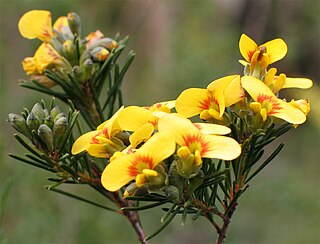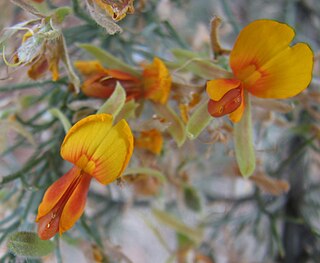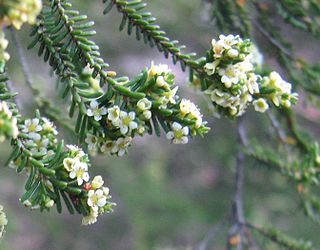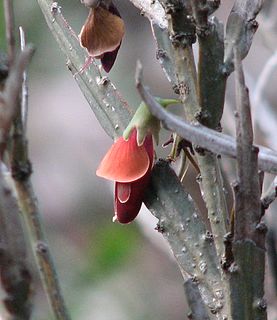
Grevillea is a diverse genus of about 360 species of evergreen flowering plants in the family Proteaceae, native to rainforest and more open habitats in Australia, New Guinea, New Caledonia, Sulawesi and other Indonesian islands east of the Wallace Line. It was named in honour of Charles Francis Greville. The species range from prostrate shrubs less than 50 cm (20 in) tall to trees 35 m (115 ft) tall. Common names include grevillea, spider flower, silky oak and toothbrush plant. Closely related to the genus Hakea, the genus gives its name to the subfamily Grevilleoideae.

Hakea is a genus of about 150 species of plants in the Family Proteaceae and are endemic to Australia. They are shrubs or small trees with leaves that are sometimes flat, otherwise circular in cross section in which case they are sometimes divided. The flowers are usually arranged in groups in leaf axils and resemble those of other genera, especially Grevillea. Hakeas have woody fruit which distinguishes them from grevilleas which have non-woody fruit which release the seeds as they mature. Hakeas are found in every state of Australia with the highest species diversity being found in the south west of Western Australia.

Dillwynia is a plant genus of the family Fabaceae. They are endemic to Australia, occurring in all states except the Northern Territory.

Chorizema is a genus of the legume family Fabaceae. They are small, evergreen shrubs and climbers native to scrub habitats in Australia, valued in cultivation for their pea-like flowers. Most species do not tolerate frost, and in temperate regions require the protection of glass.

Gastrolobium is a genus of flowering plants in the family Fabaceae. There are over 100 species in this genus, and all but two are native to the south west region of Western Australia.

Mirbelia is a plant genus belonging to the family Fabaceae. It is endemic to Australia, occurring in every mainland state except South Australia.

Gompholobium, commonly known as glory peas or wedge-peas, is a genus of plants in the pea family, Fabaceae and is endemic to Australia. Most species have compound leaves composed of three leaflets and all have ten stamens which are free from each other and a distinctive arrangement of their sepals.

Dampiera is a genus of plants in the Goodeniaceae family which are endemic to Australia occurring in all states. They are herbaceous plants or small shrubs which have blue or purple flowers with yellow centres. The genus is named for William Dampier, an English sea captain and scientific observer. Dampiera diversifolia is sometimes grown in gardens as an ornamental.

Thryptomene is a genus of small shrubs in the family Myrtaceae described as a genus in 1838. The entire genus is endemic to Australia.

Jacksonia is a genus of about forty, mostly leafless broom-like shrubs or small trees in the flowering plant family Fabaceae. The genus is endemic to Australia and species occur in a range of habitats in all Australian states except South Australia.

Hypocalymma is a genus of evergreen shrubs in the myrtle family Myrtaceae described as a genus in 1840. The entire genus is endemic to southern Western Australia.

Micromyrtus is a genus of shrubs, in the family Myrtaceae, described as a genus in 1865. The entire genus is endemic to Australia.

Bossiaea is a genus in the pea family (Fabaceae) consisting of about 70 species which are native to Australia. The genus is named in honour of Joseph Hugues Boissieu La Martinière, a botanist on La Pérouse's expedition to Australia.

Petrophile is a genus of evergreen shrubs, in the family Proteaceae. The genus is endemic to Australia. Commonly known as conebushes, they typically have prickly, divided foliage and produce prominently-displayed pink, yellow or cream flowers followed by grey, conical fruits.

Daviesia, commonly known as Bitter-peas, is a large genus of flowering plants in the legume family. They are native to Australia, with a centre of diversity in Western Australia.

Chamelaucieae is a tribe of flowering plants within the family Myrtaceae.
















